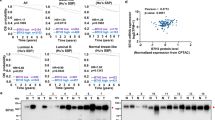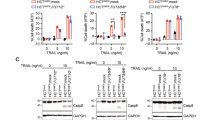Abstract
Immune checkpoint blockade therapy has drastically improved the prognosis of certain advanced-stage cancers. However, low response rates and immune-related adverse events remain important limitations. Here, we report that inhibiting ALG3, an a-1,3-mannosyltransferase involved in protein glycosylation in the endoplasmic reticulum (ER), can boost the response of tumors to immune checkpoint blockade therapy. Deleting N-linked glycosylation gene ALG3 in mouse cancer cells substantially attenuates their growth in mice in a manner depending on cytotoxic T cells. Furthermore, ALG3 inhibition or N-linked glycosylation inhibitor tunicamycin treatment synergizes with anti-PD1 therapy in suppressing tumor growth in mouse models of cancer. Mechanistically, we found that inhibiting ALG3 induced deficiencies of post-translational N-linked glycosylation modification and led to excessive lipid accumulation through sterol-regulated element-binding protein (SREBP1)-dependent lipogenesis in cancer cells. N-linked glycosylation deficiency-mediated lipid hyperperoxidation induced immunogenic ferroptosis of cancer cells and promoted a pro-inflammatory microenvironment, which boosted anti-tumor immune responses. In human subjects with cancer, elevated levels of ALG3 expression in tumor tissues are associated with poor patient survival. Taken together, we reveal an unappreciated role of ALG3 in regulating tumor immunogenicity and propose a potential therapeutic strategy for enhancing cancer immunotherapy.






Similar content being viewed by others
Availability of data and materials
The data sets generated correlations between ferroptosis and immune gene expression profile during the current study are available in the public RNA sequencing data from NCBI Gene Expression Omnibus (accession number: GSE128392) All other data generated or analyzed during this study are included in this published article and its supplementary information files.
References
Pinho SS, Reis CA (2015) Glycosylation in cancer: mechanisms and clinical implications. Nat Rev Cancer 15(9):540–555. https://doi.org/10.1038/nrc3982
Clerc F, Reiding KR, Jansen BC, Kammeijer GS, Bondt A, Wuhrer M (2016) Human plasma protein N-glycosylation. Glycoconj J. 33(3):309–343. https://doi.org/10.1007/s10719-015-9626-2
Tim C, Huffaker PWR (1983) Yeast mutants deficient in protein glycosylation. Proc Natl Acad Sci USA 80:7466–7470
Leto DE, Morgens DW, Zhang L et al (2019) Genome-wide CRISPR analysis identifies substrate-specific conjugation modules in ER-associated degradation. Mol Cell 73(2):377-389 e11. https://doi.org/10.1016/j.molcel.2018.11.015
Liu K, Tan S, Jin W et al (2020) N-glycosylation of PD-1 promotes binding of camrelizumab. EMBO Rep 21(12):e51444. https://doi.org/10.15252/embr.202051444
Krishnan V, Bane SM, Kawle PD, Naresh KN, Kalraiya RD (2005) Altered melanoma cell surface glycosylation mediates organ specific adhesion and metastasis via lectin receptors on the lung vascular endothelium. Clin Exp Metastasis 22(1):11–24. https://doi.org/10.1007/s10585-005-2036-2
Bettigole SE, Glimcher LH (2015) Endoplasmic reticulum stress in immunity. Annu Rev Immunol 33:107–138. https://doi.org/10.1146/annurev-immunol-032414-112116
Frakes AE, Dillin A (2017) The UPR(ER): sensor and coordinator of organismal homeostasis. Mol Cell 66(6):761–771. https://doi.org/10.1016/j.molcel.2017.05.031
Tufanli O, TelkoparanAkillilar P, Acosta-Alvear D et al (2017) Targeting IRE1 with small molecules counteracts progression of atherosclerosis. Proc Natl Acad Sci USA 114(8):E1395–E1404. https://doi.org/10.1073/pnas.1621188114
Azim MHS (1979) Glycoprotein synthesis and inhibition of glycosylation by tunicamycin in preimplantation mouse embryos: compaction and trophoblast adhesion. Cell 1979(18):217–227
Figueroa-Juarez E, Noriega LG, Perez-Monter C et al (2021) The role of the unfolded protein response on renal lipogenesis in C57BL/6 mice. Biomolecules. https://doi.org/10.3390/biom11010073
Cheng C, Ru P, Geng F et al (2015) Glucose-mediated N-glycosylation of SCAP is essential for SREBP-1 activation and tumor growth. Cancer Cell 28(5):569–581. https://doi.org/10.1016/j.ccell.2015.09.021
Han J, Kaufman RJ (2016) The role of ER stress in lipid metabolism and lipotoxicity. J Lipid Res 57(8):1329–1338. https://doi.org/10.1194/jlr.R067595
Gao M, Monian P, Pan Q, Zhang W, Xiang J, Jiang X (2016) Ferroptosis is an autophagic cell death process. Cell Res 26(9):1021–1032. https://doi.org/10.1038/cr.2016.95
Muir A, Danai LV, Gui DY, Waingarten CY, Lewis CA, Vander Heiden MG (2017) Environmental cystine drives glutamine anaplerosis and sensitizes cancer cells to glutaminase inhibition. Elife. https://doi.org/10.7554/eLife.27713
Yang WS, Stockwell BR (2016) Ferroptosis: death by lipid peroxidation. Trends Cell Biol 26(3):165–176. https://doi.org/10.1016/j.tcb.2015.10.014
Xie Y, Hou W, Song X et al (2016) Ferroptosis: process and function. Cell Death Differ 23(3):369–379. https://doi.org/10.1038/cdd.2015.158
Doll S, Freitas FP, Shah R et al (2019) FSP1 is a glutathione-independent ferroptosis suppressor. Nature 575(7784):693–698. https://doi.org/10.1038/s41586-019-1707-0
Stockwell BR, Friedmann Angeli JP, Bayir H et al (2017) Ferroptosis: a regulated cell death nexus linking metabolism, redox biology, and disease. Cell 171(2):273–285. https://doi.org/10.1016/j.cell.2017.09.021
Brown CW, Amante JJ, Chhoy P et al (2019) Prominin2 drives ferroptosis resistance by stimulating iron export. Dev Cell 51(5):575-586 e4. https://doi.org/10.1016/j.devcel.2019.10.007
Xu C, Sun S, Johnson T et al (2021) The glutathione peroxidase Gpx4 prevents lipid peroxidation and ferroptosis to sustain Treg cell activation and suppression of antitumor immunity. Cell Rep 35(11):109235. https://doi.org/10.1016/j.celrep.2021.109235
Tang D, Chen X, Kang R, Kroemer G (2021) Ferroptosis: molecular mechanisms and health implications. Cell Res 31(2):107–125. https://doi.org/10.1038/s41422-020-00441-1
Schinzel RT, Higuchi-Sanabria R, Shalem O et al (2019) The hyaluronidase, TMEM2, promotes ER homeostasis and longevity independent of the UPR(ER). Cell 179(6):1306-1318 e18. https://doi.org/10.1016/j.cell.2019.10.018
Li B, Li C, Guo M et al (2018) Predictive value of LDH kinetics in bevacizumab treatment and survival of patients with advanced NSCLC. Onco Targets Ther 11:6287–6294. https://doi.org/10.2147/OTT.S171566
Aregger M, Lawson KA, Billmann M et al (2020) Systematic mapping of genetic interactions for de novo fatty acid synthesis identifies C12orf49 as a regulator of lipid metabolism. Nat Metab 2(6):499–513. https://doi.org/10.1038/s42255-020-0211-z
Urata S, Yun N, Pasquato A, Paessler S, Kunz S, de la Torre JC (2011) Antiviral activity of a small-molecule inhibitor of arenavirus glycoprotein processing by the cellular site 1 protease. J Virol 85(2):795–803. https://doi.org/10.1128/JVI.02019-10
Geng F, Cheng X, Wu X et al (2016) Inhibition of SOAT1 suppresses glioblastoma growth via blocking SREBP-1-mediated lipogenesis. Clin Cancer Res 22(21):5337–5348. https://doi.org/10.1158/1078-0432.CCR-15-2973
Davidson RC, Nett JH, Renfer E et al (2004) Functional analysis of the ALG3 gene encoding the Dol-P-Man: Man5GlcNAc2-PP-Dol mannosyltransferase enzyme of P. pastoris. Glycobiology 14(5):399–407. https://doi.org/10.1093/glycob/cwh023
Maurel M, Samali A, Chevet E (2014) Endoplasmic reticulum stress: at the crossroads of inflammation and metabolism in hepatocellular carcinoma development. Cancer Cell 26(3):301–303. https://doi.org/10.1016/j.ccr.2014.08.007
Keestra-Gounder AM, Byndloss MX, Seyffert N et al (2016) NOD1 and NOD2 signalling links ER stress with inflammation. Nature 532(7599):394–397. https://doi.org/10.1038/nature17631
Spiteller G, Afzal M (2014) The action of peroxyl radicals, powerful deleterious reagents, explains why neither cholesterol nor saturated fatty acids cause atherogenesis and age-related diseases. Chemistry 20(46):14928–14945. https://doi.org/10.1002/chem.201404383
Hadian K, Stockwell BR (2020) SnapShot: ferroptosis. Cell 181(5):1188-1188 e1. https://doi.org/10.1016/j.cell.2020.04.039
Dixon SJ, Lemberg KM, Lamprecht MR et al (2012) Ferroptosis: an iron-dependent form of nonapoptotic cell death. Cell 149(5):1060–1072. https://doi.org/10.1016/j.cell.2012.03.042
Zeng C, Tang H, Chen H, Li M, Xiong D (2020) Ferroptosis: a new approach for immunotherapy. Cell Death Discov 6(1):122. https://doi.org/10.1038/s41420-020-00355-2
Wang W, Green M, Choi JE et al (2019) CD8(+) T cells regulate tumour ferroptosis during cancer immunotherapy. Nature 569(7755):270–274. https://doi.org/10.1038/s41586-019-1170-y
Liu X, Bao X, Hu M et al (2020) Inhibition of PCSK9 potentiates immune checkpoint therapy for cancer. Nature 588(7839):693–698. https://doi.org/10.1038/s41586-020-2911-7
Hogquist KA, Jameson SC, Heath WR, Howard JL, Bevan MJ, Carbone FR (1994) T cell receptor antagonist peptides induce positive selection. Cell 76(1):17–27. https://doi.org/10.1016/0092-8674(94)90169-4
Himmelreich N, Dimitrov B, Geiger V et al (2019) Novel variants and clinical symptoms in four new ALG3-CDG patients, review of the literature, and identification of AAGRP-ALG3 as a novel ALG3 variant with alanine and glycine-rich N-terminus. Hum Mutat 40(7):938–951. https://doi.org/10.1002/humu.23764
Ke SB, Qiu H, Chen JM et al (2020) ALG3 contributes to the malignancy of non-small cell lung cancer and is negatively regulated by MiR-98-5p. Pathol Res Pract 216(3):152761. https://doi.org/10.1016/j.prp.2019.152761
Zhou H, Cao T, Li WP, Wu G (2019) Combined expression and prognostic significance of PPFIA1 and ALG3 in head and neck squamous cell carcinoma. Mol Biol Rep 46(3):2693–2701. https://doi.org/10.1007/s11033-019-04712-y
Li Y, Weng Y, Pan Y et al (2021) A novel prognostic signature based on metabolism-related genes to predict survival and guide personalized treatment for head and neck squamous carcinoma. Front Oncol 11:685026. https://doi.org/10.3389/fonc.2021.685026
Sun X, He Z, Guo L et al (2021) ALG3 contributes to stemness and radioresistance through regulating glycosylation of TGF-beta receptor II in breast cancer. J Exp Clin Cancer Res 40(1):149. https://doi.org/10.1186/s13046-021-01932-8
Friedmann Angeli JP, Krysko DV, Conrad M (2019) Ferroptosis at the crossroads of cancer-acquired drug resistance and immune evasion. Nat Rev Cancer 19(7):405–414. https://doi.org/10.1038/s41568-019-0149-1
Lee HH, Wang YN, Xia W et al (2019) Removal of N-linked glycosylation enhances PD-L1 detection and predicts anti-PD-1/PD-L1 therapeutic efficacy. Cancer Cell 36(2):168-178 e4. https://doi.org/10.1016/j.ccell.2019.06.008
Cha JH, Yang WH, Xia W et al (2018) Metformin promotes antitumor immunity via endoplasmic-reticulum-associated degradation of PD-L1. Mol Cell 71(4):606-620 e7. https://doi.org/10.1016/j.molcel.2018.07.030
Li CW, Lim SO, Xia W et al (2016) Glycosylation and stabilization of programmed death ligand-1 suppresses T-cell activity. Nat Commun 7:12632. https://doi.org/10.1038/ncomms12632
Dunn WB, Broadhurst D, Begley P et al (2011) Procedures for large-scale metabolic profiling of serum and plasma using gas chromatography and liquid chromatography coupled to mass spectrometry. Nat Protoc 6(7):1060–1083. https://doi.org/10.1038/nprot.2011.335
Sarafian MH, Gaudin M, Lewis MR et al (2014) Objective set of criteria for optimization of sample preparation procedures for ultra-high throughput untargeted blood plasma lipid profiling by ultra performance liquid chromatography-mass spectrometry. Anal Chem 86(12):5766–5774. https://doi.org/10.1021/ac500317c
Funding
This work was supported by Guangdong Basic and Applied Basic Research Foundation Grant (2020B1515020054), and Shenzhen Science and Technology Program Grant (JCY20190807154813511).
Author information
Authors and Affiliations
Contributions
Conception and design: XL, CL. Development of methodology: PL, CL, JC, QH, J-AP. Acquisition of data: PL, CL, ZL, CZ, DX, ZL, LH. Writing, review, and/or revision of the manuscript: XL, PL. Study supervision: XL.
Corresponding author
Ethics declarations
Conflict of interest
The authors declare no competing interests.
Ethical approval
All animal experiment protocols were approved by the Sun Yat-sen University Institutional Animal Use and Care Committee.
Consent for publication
All authors provided their consent to publish the study.
Additional information
Publisher's Note
Springer Nature remains neutral with regard to jurisdictional claims in published maps and institutional affiliations.
Supplementary Information
Below is the link to the electronic supplementary material.
Rights and permissions
About this article
Cite this article
Liu, P., Lin, C., Liu, Z. et al. Inhibition of ALG3 stimulates cancer cell immunogenic ferroptosis to potentiate immunotherapy. Cell. Mol. Life Sci. 79, 352 (2022). https://doi.org/10.1007/s00018-022-04365-4
Received:
Revised:
Accepted:
Published:
DOI: https://doi.org/10.1007/s00018-022-04365-4




